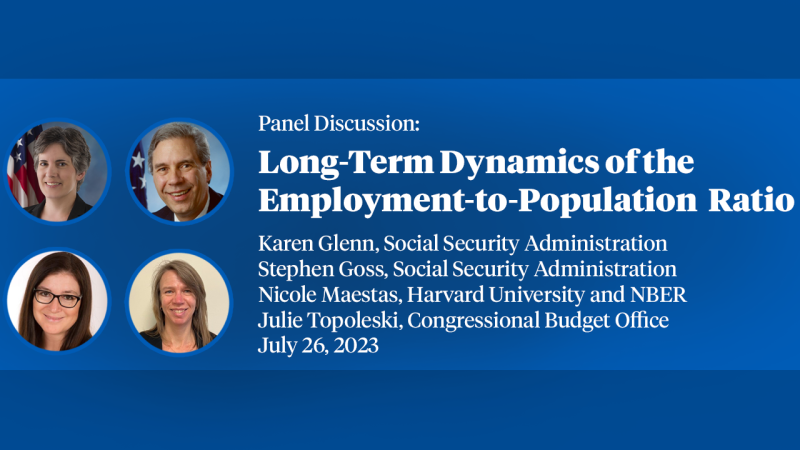Programs
Research programs are the backbone of the NBER. Each of the 19 programs corresponds loosely to a traditional field of study within economics. Each NBER affiliate is associated with one or more programs. Programs are led by a Director or co-Directors, and host at least two meetings each year, including one at the NBER Summer Institute.
Program
The Program on the Economics of Aging studies the health and economic circumstances of individuals as they age with particular emphasis on late-life experiences, as well as the broader economic consequences of population aging.
Program
The Asset Pricing Program explores the factors that determine the prices of and returns on financial and real assets, including stocks, bonds, currencies, and real estate. It also studies the behavior of households and firms that invest in these assets.
Program
The Program on Children uses economic tools to study the determinants of children’s well-being. It considers the role of education, public and private health insurance, and transfer programs, as well as the long-run economic and social consequences of early-life circumstances.
Program
The Corporate Finance Program explores the determinants and consequences of the financing decisions made by firms and households. It also encompasses corporate governance, household finance, and the links between the real and financial sectors of the economy.
Program
The Development Economics Program studies the forces that contribute to economic development, particularly in less developed nations. It explores the role of decisions by households, firms, and governments, the effects of development aid policies, and the consequences of rising incomes in emerging economies.
Program
The Program on the Development of the American Economy explores the sources of long-run growth and fluctuations in the US economy. It considers the contributions of human and physical capital, as well as the role of public policy.
Program
The Economic Fluctuations and Growth Program investigates both long-term trends and short-term fluctuations in aggregate employment, output, and prices. It explores the nature of business cycles, particularly in the United States, as well as the effects of monetary and fiscal policy on economic performance.
Program
The Education Program studies the effect of education on individuals’ earnings and other outcomes, as well as the effect of educational inputs and education policies on student achievement.
Program
Researchers affiliated with the Economics of Health Program study the economic determinants of health, the operation of health care markets, and the financing of health care with particular emphasis on public and private insurance. Core topics of interest include the determinants of "health capital" and the consequences of unhealthy behaviors such as substance abuse, the role of market failure in health care and health insurance markets, and the impact of public policies on health care delivery, expenditures, financing, and innovation. The program is the successor to the Health Care and Health Economics Programs, which merged in July 2023.
Program
The Environment and Energy Economics Program studies the economics of the energy sector, the determinants of pollution and other actions that affect the environment, and the effects of public policies in both of these areas.
Program
The Industrial Organization Program analyzes firm behavior and industry dynamics, including the determinants of market competition and of pricing decisions, as well as the effects of public policies such as anti-trust law and government regulation.
Program
The International Finance and Macroeconomics Program studies financial interactions among nations, including cross-border capital flows, exchange rates, responses to global financial crises, and transmission of economic shocks.
Program
The International Trade and Investment Program examines the causes and consequences of trade between and among nations and regions. It considers how transportation costs, tariffs, and other factors affect geographic specialization and commercial flows.
Program
The Labor Studies Program explores issues related to employment and compensation, including the supply of and demand for labor, human capital, and the determinants and consequences of unemployment. It also considers the effects of labor unions and policies such as minimum wages and training programs.
Program
The Law and Economics Program studies the economic causes and consequences of specific legal rules as well as the impact of the broader legal system. It encompasses the behavior of firms and individuals, and considers property rights, deterrence, and the effects of law enforcement.
Program
The Monetary Economics Program studies the conduct and effects of monetary policy, including its impact on interest rates and inflation, and the consequences of policy actions by central banks. It also considers macroeconomic forces that impinge on central bank decision-making.
Program
The Political Economy Program examines the interactions among political institutions, participants in the political system, such as voters and elected officials, and economic outcomes broadly defined.
Program
The Productivity, Innovation, and Entrepreneurship Program studies firm-level and economy-wide forces that determine productivity. It emphasizes the factors that affect innovation, patenting, entrepreneurship, and the creation of new firms, while also exploring broader issues such as the productivity effects of firms’ investment spending and the composition of the labor force.
Program
The Public Economics Program explores the efficiency and distributional effects of various tax policies and government spending programs, as well as the way that these programs affect the behavior of households and firms.
Working Groups
Working Group
The Behavioral Finance Working Group studies financial markets using approaches grounded in psychological research, with applications in asset pricing, corporate finance, and household finance.
Working Group
The Chinese Economy Working Group studies the Chinese economy, convening meetings in both the U.S. and China. Core topic areas include development and growth, labor and housing markets, macroeconomic, trade, and financial policies, and demographic change.
Working Group
The Cohort Studies Working Group investigates changes in health and other dimensions of well-being across generations, with a particular emphasis on the creation and use of longitudinal data sets.
Working Group
The Crime Working Group studies economic elements of the causes and consequences of crime, with particular emphasis on interventions in the criminal justice system and elsewhere that may lower crime rates.
Working Group
The Entrepreneurship Working Group studies the dynamics of firm creation and the factors that influence it, including the career choices of entrepreneurs and the capital market and regulatory environment facing young firms.
Working Group
Women play diverse and critical roles in the economies of both developing and developed nations. Yet, they often remain severely constrained from realizing their full personal and economic potential as a result of insufficient access to formal financial services, work, and education, disempowering social norms, and gender-biased laws and institutions. Research among economists that describes these various constraints and evaluates interventions to remove them is often siloed in different subfields of economics. This working group, which builds on the activities of the Study Group on Gender and the Economy that was funded by the Bill and Melinda Gates Foundation, provides a venue for explicitly anchoring research discussions on these topics. It brings together researchers from different fields of economics who are working on these topics to share and discuss current research findings.
Working Group
The Household Finance Working Group studies household saving, portfolio behavior, borrowing, and investment decisions. It considers the effects of regulation and other public policies, as well as innovations in the market environment.
Working Group
The Innovation Policy Working Group studies the determinants and consequences of innovation, with particular attention to patent policy, public support for research, and the interactions between firms, universities, and government.
Working Group
The Insurance Working Group studies the demand for insurance products by households and firms, the role of regulations and other factors in affecting insurance market equilibrium, and the interaction between publicly- and privately-provided insurance.
Working Group
The Market Design Working Group studies market institutions such as auctions, queues, assignment rules in school systems, clearinghouses, and tradeable permit systems. It emphasizes the role of institutional design in determining market outcomes and the well-being of market participants.
Working Group
The Organizational Economics Working Group studies the structures that govern non-market transactions, such as transactions within firms, government agencies, and non-profit organizations. It also considers the boundaries of the firm and the role of contracts and other structures that mediate transactions between firms.
Working Group
The Personnel Economics Working Group studies human resource questions that arise within firms, including hiring, promotion policy, the design of cash compensation and benefit packages, and outsourcing.
Working Group
The Working Group on Race and Stratification in the Economy explores the role of public policies, private practices, and historical factors in contributing to and ameliorating racial disparities in economic outcomes. It also considers, broadly, ways to better integrate race into all aspects of economic analysis.
Working Group
The Urban Economics Working Group studies the economics of cities and the many policies and factors that determine city structure and performance, such as land use restrictions, local labor markets, agglomeration economies, trade, and transportation infrastructure.


